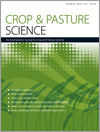This study investigated the ability of several plant species commonly occurring as weeds in Australian cropping systems to produce root exudates that inhibit nitrification via biological nitrification inhibition (BNI). Seedlings of wild radish (Raphanus raphanistrum), great brome grass (Bromus diandrus), wild oats (Avena fatua), annual ryegrass (Lolium rigidum) and Brachiaria humidicola (BNI-positive control) were grown in hydroponics, and the impact of their root exudates on NO3– production by Nitrosomonas europaea was measured in a pure-culture assay. A pot study (soil-based assay) was then conducted to confirm the ability of the weeds to inhibit nitrification in whole soils. All of the tested weeds slowed NO3– production by N. europaea in the pure-culture assay and significantly inhibited potential nitrification rates in soil-based assays. Root exudates produced by wild radish were the most inhibitory, slowing NO3– production by the pure culture of N. europaea by 53 ± 6.1% and completely inhibiting nitrification in the soil-based assay. The other weed species all had BNI capacities comparable to that of B. humidicola and significantly higher than that previously reported for wheat cv. Janz. This study demonstrates that several commonly occurring weed species have BNI capacity. By altering the N cycle, and retaining NH4 in the soils in which they grow, these weeds may gain a competitive advantage over species (including crops) that prefer NO3–. Increasing our understanding of how weeds compete with crops for N may open avenues for novel weed-management strategies.
How to translate text using browser tools
6 October 2017
Biological nitrification inhibition by weeds: wild radish, brome grass, wild oats and annual ryegrass decrease nitrification rates in their rhizospheres
Cathryn A. O’ Sullivan,
Kelley Whisson,
Karen Treble,
Margaret M. Roper,
Shayne F. Micin,
Philip R. Ward
ACCESS THE FULL ARTICLE

Crop and Pasture Science
Vol. 68 • No. 8
October 2017
Vol. 68 • No. 8
October 2017
Ammonium
Nitrification
nitrification inhibitors
weed ecology




